Charles IV of Spain facts for kids
Quick facts for kids Charles IV |
|||||
|---|---|---|---|---|---|
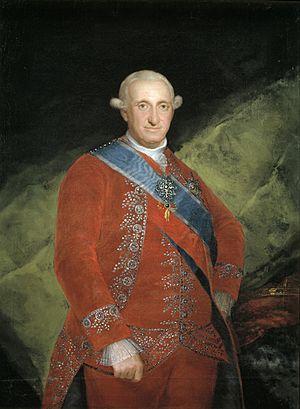
Portrait by Goya, 1789
|
|||||
| King of Spain (more...) | |||||
| Reign | 14 December 1788 – 19 March 1808 |
||||
| Predecessor | Charles III | ||||
| Successor | Ferdinand VII | ||||
| Chief Ministers | |||||
| Born | 11 November 1748 Palace of Portici, Portici, Naples |
||||
| Died | 20 January 1819 (aged 70) Palazzo Barberini, Rome, Papal States |
||||
| Burial | El Escorial | ||||
| Spouse | |||||
| Issue |
|
||||
|
|||||
| House | Bourbon-Anjou | ||||
| Father | Charles III of Spain | ||||
| Mother | Maria Amalia of Saxony | ||||
| Religion | Roman Catholic | ||||
| Signature |  |
||||
Charles IV (born Carlos Antonio Pascual Francisco Javier Juan Nepomuceno José Januario Serafín Diego de Borbón y Sajonia; 11 November 1748 – 20 January 1819) was the King of Spain and ruler of the large Spanish Empire from 1788 to 1808.
When Charles IV became king, Spain seemed stable. However, during his rule, Spain faced many challenges. The country got involved in difficult alliances and always needed money for wars. Charles did not get along with his son, Ferdinand. Ferdinand tried to take power in 1807 and later forced Charles to give up his throne in 1808. This also led to the removal of Charles's main minister, Manuel de Godoy, whom many people disliked. Later, Napoleon Bonaparte called both Charles and Ferdinand to Bayonne. Napoleon forced them both to give up their claims to the throne. This allowed Napoleon to make his brother, Joseph Bonaparte, the King of Spain. Charles IV's time as king was a very important turning point in Spanish history.
Contents
Early Life of Charles IV
Charles was the second son of King Charles III and his wife, Maria Amalia of Saxony. He was born in Naples on November 11, 1748. At that time, his father was the King of Naples and Sicily. Charles's older brother, Don Felipe, could not inherit the thrones because of health challenges. In Naples and Sicily, Charles was known as the Prince of Taranto. People also called him El Cazador, which means "the Hunter." This was because he loved hunting and sports more than dealing with government matters. Historians describe Charles as a kind person, but not a very strong leader.
On November 18, 1791, King Charles IV officially created the "Royal University of Guadalajara." Today, this is known as the University of Guadalajara.
Charles IV's Reign
In 1788, Charles III passed away, and Charles IV became king. He ruled for the next two decades. Charles believed strongly in the power of the monarchy. He tried to appear as an absolute and powerful king. However, Charles never took a very active role in running the government. Most of the government's work was left to his wife, Maria Luisa, and his main minister, Manuel de Godoy.
While Charles spent his time hunting, big events were happening in Europe. The French Revolution began, and his relatives, King Louis XVI of France and his queen, Marie Antoinette, were executed. Then, Napoleon Bonaparte started to rise to power. Ideas from the Age of Enlightenment had already reached Spain. Charles's father, Charles III, had worked hard to make Spain stronger. He wanted to improve Spain's politics and economy. But Charles IV was a king who did not do much. He had a strong-willed wife and an ambitious minister, Godoy. People thought the queen and Godoy were too close. This made many people lose respect for the monarchy.
When Charles IV became king, he wanted to continue his father's policies. So, he kept his father's prime minister, the Count of Floridablanca. Floridablanca managed to avoid war with Great Britain during the Nootka Crisis. This was a small dispute about trade and navigation near Vancouver Island in 1789. Spain could have asked France for help, but France refused. Floridablanca had to agree to Britain's terms, which was a bit humiliating for Spain.
In 1792, Floridablanca's enemies removed him from office. He was replaced by the Count of Aranda. However, after France became a republic and war started, Aranda was replaced. The new minister was Manuel de Godoy. Godoy was a favorite of the Queen, and the King also liked him very much.
Under Charles IV, scientific expeditions continued. Some of these were started by his father, Charles III. The Royal Botanical Expedition to New Granada (1783–1816) and the Royal Botanical Expedition to New Spain (1787–1803) were paid for by the crown. The Malaspina Expedition (1789–94) was another important scientific journey. It was led by Spanish naval commander Alejandro Malaspina. Scientists and artists collected information for the Spanish crown.
In 1803, Charles IV approved the Balmis Expedition. This mission aimed to vaccinate people in Spain's overseas territories against smallpox. It also helped make it safer for slave ships to travel without smallpox outbreaks. In 1799, Charles IV allowed a Prussian scientist, Alexander von Humboldt, to travel freely in Spanish America. Royal officials were told to help him study important areas of the Spanish Empire. Humboldt's book, Political Essay on the Kingdom of New Spain, was a key result of his five years of travel.
Spain had long-standing money problems. These got worse when Spain became involved in wars that its ally, France, was fighting. The need for money shaped Charles's policies at home and abroad. Godoy's economic plans made people even more unhappy with Charles's rule.
To try and fix the economy, Gaspar Melchor de Jovellanos suggested big changes to land ownership. He wanted to help farming grow again. In his 1795 work, he argued that Spain needed strong agriculture for its people to grow and do well. He believed that land being owned by only a few people was a major problem. He suggested selling public lands and lands owned by the Catholic Church. He also wanted to end mayorazgos, which were rules that kept large estates together for generations of noble families. These changes aimed to create more small farmers in Spain. This would make farmland more productive. But it would also reduce the power of the Church and the rich nobles.
As the money situation became more urgent, the crown took action in 1804. It forced the Church in its overseas empire to demand immediate payment on long-term loans. This was meant to reduce the Church's wealth. However, it also hurt wealthy landowners who had borrowed money from the Church. They suddenly had to pay back large amounts of money. This royal order is seen as a big reason for the independence movements in places like New Spain (Mexico). The order was stopped later, but it had already made many powerful people unhappy.
In foreign policy, Godoy first tried to stay neutral towards France. But after Spain protested the execution of King Louis XVI of France in 1793, France declared war on Spain. Then, Portugal and Spain signed a treaty to protect each other from France. In 1796, France forced Godoy to form an alliance with them. Spain then declared war on the Kingdom of Great Britain. As a result, Spain became an ally of Republican France in the French Revolutionary Wars for a long time.
Spain remained allied with France for a while. They lost against the British in the battle of Trafalgar. Spain also supported the Continental Blockade, which was Napoleon's plan to stop trade with Britain. After Napoleon defeated Prussia in 1807, Godoy kept Spain on the French side.
However, constantly changing alliances made Charles seem unreliable. This made Godoy even more unpopular. It also strengthened the fernandistas, who were supporters of Crown Prince Ferdinand. They wanted an alliance with the United Kingdom.
Money problems, rumors about the Queen and Godoy, and the King's weak leadership made the monarchy less respected. Crown Prince Ferdinand wanted to take over from his father. He was also jealous of the prime minister. In 1807, Ferdinand tried to overthrow the King, but it failed. He succeeded in 1808, forcing his father to give up the throne after the Tumult of Aranjuez.
The Abdications of Bayonne
Riots and a popular uprising at the winter palace Aranjuez in 1808 forced King Charles to give up his throne on March 19. His son, Ferdinand, became King Ferdinand VII. However, Napoleon did not trust Ferdinand. By this time, Napoleon had 100,000 soldiers in Spain because of the ongoing war.
The former King Charles, wanting to get his throne back, asked Napoleon for help. Napoleon called both Charles and his son to Bayonne in April 1808. Napoleon then forced both Charles and Ferdinand to give up their claims to the Spanish throne. He declared that the Bourbon royal family of Spain was no longer in power. Napoleon then made his brother, Joseph Bonaparte, King Joseph I of Spain. This event started the Peninsular War.
Later Life and Death
After Napoleon removed the Bourbon family from power, the former King Charles, his wife, and former Prime Minister Godoy were held in France. They were first at the château de Compiègne and then for three years in Marseille. After Napoleon's rule ended, Ferdinand VII became king again. Charles IV traveled around Europe until 1812. He finally settled in Rome, at the Palazzo Barberini. His wife died on January 2, 1819. Charles followed shortly after, dying on January 20 of the same year.
Character
Charles IV was a kind and religious person. However, he struggled with many international problems that were too big for him to handle. The famous artist Francisco Goya painted many official portraits of the King. Some art experts believe these paintings subtly showed the King's lack of strong leadership.
Marriage and Children
Charles IV married his first cousin, Maria Louisa, in 1765. She was the daughter of Philip, Duke of Parma. The couple had fourteen children together. Seven of their children lived to be adults.
| Children of King Charles IV | |||
|---|---|---|---|
| Name | Portrait | Lifespan | Notes |
| Carlota Joaquina Queen of Portugal and the Algarves |
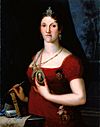 |
25 April 1775 – 7 January 1830 | She married John VI of Portugal in 1785 and became Queen of Portugal in 1816. She had children, including the future Pedro I of Brazil. |
| Maria Luisa Queen of Etruria Duchess of Lucca |
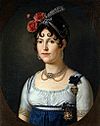 |
6 July 1782 – 13 March 1824 | She married Louis, King of Etruria in 1795 and had children, including Charles II, Duke of Parma. She became Duchess of Lucca in 1817. |
| Fernando (VII) King of Spain |
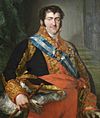 |
14 October 1784 – 29 September 1833 | He became King after his father in 1808, but Napoleon removed him a month later. He was made King again in 1813. He married four times and had children, including the future Isabella II of Spain. |
| Carlos María Isidro Benito Count of Molina |
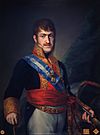 |
29 March 1788 – 10 March 1855 | He married Infanta Maria Francisca of Portugal and had children. He was the first Carlist claimant to the Spanish throne as "Carlos V." |
| María Isabel Queen of the Two Sicilies |
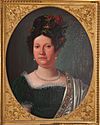 |
6 July 1789 – 13 September 1848 | She married Francis I of the Two Sicilies in 1802 and had children, including the future Ferdinand II of the Two Sicilies. She was Queen from 1825 to 1830. |
| Francisco de Paula | 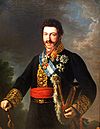 |
10 March 1794 – 13 August 1865 | He married Princess Luisa Carlotta of Naples and Sicily in 1819 and had children. |
Images for kids
-
Count de Floridablanca, painting by Goya ca. 1783
See also
 In Spanish: Carlos IV de España para niños
In Spanish: Carlos IV de España para niños










